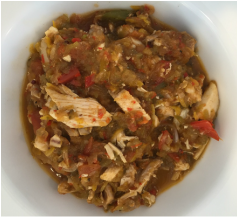 A ninth-generation Kentuckian, I grew up eating Burgoo (“BUR-goo”)—the infamous spicy stew known as the Bluegrass State’s Official Dish and a Kentucky crowd-pleaser for more than 150 years. And I sure start to crave it around the first Saturday in May. So today, in honor of the Kentucky Derby, I created a healthy Paleo-version of the infamous Kentucky Burgoo! Healthy Kentucky Derby Burgoo Serves a heap of folks a little, or a few folks a lot Ingredients: 2 red bell peppers, seeded 2 yellow bell peppers, seeded 2 green bell peppers, seeded 2 jalapenos, seeded 2 Poblano peppers, seeded 2 large tomatoes 1 large white or yellow onion 4 garlic cloves, minced 1 chicken, roasted and shredded 1 package, Andouille chicken sausages (precooked), cubed 2 T. olive oil Jamaican jerk seasoning, to taste Pink Himalayan sea salt, to taste Cracked black pepper, to taste Cayenne pepper, to taste Apple Cider Vinegar, to taste Worcestershire Sauce, to taste Instructions: Wash and rough chop all veggies and pulse in batches in a food processor. (I used to painstakingly chop them all by hand till my Southern mother—who is a brilliant chef and 5-star Innkeeper asked me why in the world didn’t I use a food processor?) Heat all veggies in a large wok skillet or dutch oven in 2 T. olive oil. Meanwhile, shred the chicken and cube the chicken sausage and stir into the veggie mixture. Simmer on low for 15 min. then begin to add your seasonings. I’m a big believer in seasoning to taste. I love things salty and spicy, you may not. Plus, it’s the best way I know to truly teach yourself to cook and to educate your palate. Have fun, play and experiment! Simmer for 15 minutes more, taste again and adjust seasonings as desired. Note: If you prefer more of a souplike consistency, feel free to thin with chicken broth. Serve with piping hot cornbread. Mint Julep, optional. Happy Derby, y’all! Enjoy!
2 Comments
 No one enjoys conflict (well, no one healthy), but appropriately handled, conflict can be an opportunity for growth. Learning how to lovingly, respectfully, and successfully resolve conflict is one of the most important things you can do to improve any relationship. Happily, the social science research is in, and experts agree on best practices. I've compiled my personal Top 10 along with examples for you below. I use these not only in my personal life, but in my coaching practice, and, when both partners put them into practice, the results are nothing less than miraculous! 1.) We always assume the best about one another. When in doubt, we assume the most loving interpretation, or gently ask for clarification if unsure. People tend to live up or down to our expectations of them! 2.) We don’t interrupt one another. We provide a safe space for one another to feel heard. If your partner refuses to do this, this is a red flag as it implies a lack of respect and empathy, or worse—contempt. 3.) We are compassionate and curious, we make room for each other’s point of view. We mirror, validate, and affirm our partner’s experience EVEN if we don’t agree. For instance, “I’m really angry that you said X.” Response: “I hear that you’re angry that I said X, and I understand why that might feel hurtful to you. Tell me more.” And then we switch. Once we truly hear and understand one another as partners, magical things happen. Old fears fall away and true understanding and trust begins to emerge. While our partner is speaking, we pay attention and don’t “stonewall” by withdrawing emotionally. If we’re unable to do this, we request a “time out.” For more information on this technique from Imago Therapy, check out: Couples Dialogue. 4.) We don’t play the “blame game.” If we’re feeling like blaming, we stop and reframe, and use our stories. Example: We share with our partner, “When you cancelled our plans, the story I’m telling myself is that you didn’t want to spend time with me.” The other partner listens and honors and responds lovingly: “I’m sorry you felt that way! I love spending time with you. I didn’t want to cancel, but now have to be in court that day.” Misunderstanding is averted, and both partners feel heard and appreciated. For more on this social science, check out a writeup on the work of shame and vulnerability researcher and author Brené Brown. 5.) We don’t bring old wounds and old fights into the present day discussion. This is known as "kitchen sinking" (throwing everything but the kitchen sink into the conversation) and is not only incredibly harmful to the relationship, but also diverts attention from solving the challenge at hand. 6.) We don’t issue ultimatums, threats, personal attacks or say things we can’t take back. We love the person, even though we may be upset about an action. The wounds from words said or threats made in anger will persist long after the discussion has been settled or the argument has ended. Treat your relationship with tenderness and respect. 7.) We have a “safe word” that either one of us can use to request a time out of a discussion that’s getting too heated. We will use this time to cool down, collect ourselves and practice self-care, and reconnect to our loving natures. 8.) When in doubt, we agree to disagree. Agree that the relationship—and being loving and having fun together!—is more important than any one personal stance. 9.) If we do make a critical observation about our partner, we try to offset it with 9x the amount of positive comments. For more on this social science, check out a writeup on the work of psychologist John Gottman. 10.) We ask for what we need using "I" statements, as in "I need you to ask me about my day" instead of "you" ones, such as "You never ask me what kind of day I had." We take responsibility for our emotions and needs. We don't expect our partners to be mind readers. And don't forget the power of physical touch. Nonverbal emotion conveys much more than verbal ever could. There's nothing like diffusing tension with a partner with a gentle touch, a caress, holding hands. This communicates: Even though this moment is tough, I love you. We're in this together. Yours in Transformation, Kate Want to do your bit to make the world a better place? Want to feel more connected with your fellow humans making up this grand planet? Want to feel more connected with the planet itself? Two words: Practice Aloha.
In the following article, Leslie Turnbull, elegantly articulates her own experience with Aloha, and how the rest of us can benefit from living our lives this way: "Aloha works, even when things seem terrible. Especially when things seem terrible..." http://theweek.com/articles/616109/ancient-hawaiian-philosophy-change-life-make-world-better-place Yours in Transformation, Kate I watched a brilliant TED Talk on procrastination the other day that I wanted to share with you.
The grand irony of this talk was that I'd been procrastinating (yes, life coaches procrastinate too) launching this blog. And why? Because I hadn't assigned myself a deadline. Writers need deadlines. And, as you'll learn when you watch the talk, the rest of us do too. This is one reason why life coaching is so effective—we all need to be held accountable. We all need a partner invested in helping us create a road map (with deadlines!) to achieve our dreams. Please check out the video and let me know what you think, and how I can best help you achieve your goals! Yours in Transformation, Kate |
AuthorCertified Professional Coach Kate Buckley is committed to facilitating personal growth and systemic transformation. An intuitive and deep listener, she specializes in helping both individuals and organizations reframe their stories in order to reclaim their life—creating meaningful strategies to transform circumstances in order to thrive! Archives
September 2020
Categories
All
|
 RSS Feed
RSS Feed